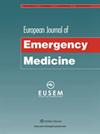Laryngeal mask vs. laryngeal tube trial in paediatric patients (LaMaTuPe): a single-blinded, open-label, randomised-controlled trial.
IF 3.1
4区 医学
Q1 EMERGENCY MEDICINE
引用次数: 0
Abstract
BACKGROUND In hypoxemic children with difficult airway, or for minor elective procedures, the use of a supraglottic airway device may be preferred to endotracheal intubation, whether with a laryngeal mask or laryngeal tube. Second-generation laryngeal masks may offer a better safety profile. Whether they should be preferred to laryngeal tubes is unknown. This study aimed to compare the efficacy and safety of second-generation laryngeal masks and laryngeal tubes in children. METHODS This randomised-controlled trial was conducted in a single university hospital in children <18 years undergoing elective anaesthesia in urology, minor paediatric surgery and gynaecology. Patients were 1 : 1 randomised to the laryngeal mask or laryngeal tube group. Children were allocated a second-generation laryngeal tube or a second-generation laryngeal mask as the primary airway device. The primary endpoint was insertion time. Secondary endpoints included first-attempt success, overall success and complications, which included hypoxia (SpO2 < 90%), laryngospasm, bronchospasm, aspiration and bleeding. RESULTS In total, 135 patients were randomised, with 61 allocated to the laryngeal tube and 74 to the laryngeal mask group, with a median age of 5.4 and 4.9 years, respectively. Median insertion time was significantly longer in the laryngeal tube group (37 vs. 31 s; difference of medians: 6.0 s; 95% confidence interval: 0.0-13.0). The laryngeal tube had a significantly lower first-attempt (41.0%) and overall success rate (45.9%) than the laryngeal mask (90.5% and 97.3%, respectively). Those allocated to the laryngeal tube group had a higher ratio of complications (27.8%) compared to the laryngeal mask group (2.7%). CONCLUSION This randomised-controlled trial reported that in children undergoing elective anaesthesia, the use of a laryngeal tube was associated with a longer insertion time.儿科患者喉罩与喉管试验(LaMaTuPe):单盲、开放标签、随机对照试验。
背景在低氧血症儿童气道困难或进行小型择期手术时,使用声门上气道装置可能优于气管插管,无论是使用喉罩还是喉管。第二代喉罩可能具有更好的安全性。至于喉罩是否优于喉管还不得而知。这项研究旨在比较第二代喉罩和喉管在儿童中的有效性和安全性。方法这项随机对照试验在一家大学医院进行,对象是接受泌尿科、儿科小手术和妇科择期麻醉的 18 岁以下儿童。患者以 1 :1 的比例随机分配到喉罩组或喉管组。患儿被分配使用第二代喉管或第二代喉罩作为主要气道装置。主要终点是插入时间。次要终点包括首次尝试成功率、总体成功率和并发症,其中并发症包括缺氧(SpO2 < 90%)、喉痉挛、支气管痉挛、吸入和出血。结果共有 135 名患者接受了随机治疗,其中 61 人被分配到喉管组,74 人被分配到喉罩组,中位年龄分别为 5.4 岁和 4.9 岁。喉管组的中位插入时间明显更长(37 秒对 31 秒;中位数差异:6.0 秒;95% 置信区间:0.0-13.0)。喉管首次尝试成功率(41.0%)和总体成功率(45.9%)明显低于喉罩(分别为 90.5% 和 97.3%)。与喉罩组相比,喉管组的并发症发生率(27.8%)更高(2.7%)。
本文章由计算机程序翻译,如有差异,请以英文原文为准。
求助全文
约1分钟内获得全文
求助全文
来源期刊
CiteScore
3.60
自引率
27.30%
发文量
180
审稿时长
6-12 weeks
期刊介绍:
The European Journal of Emergency Medicine is the official journal of the European Society for Emergency Medicine. It is devoted to serving the European emergency medicine community and to promoting European standards of training, diagnosis and care in this rapidly growing field.
Published bimonthly, the Journal offers original papers on all aspects of acute injury and sudden illness, including: emergency medicine, anaesthesiology, cardiology, disaster medicine, intensive care, internal medicine, orthopaedics, paediatrics, toxicology and trauma care. It addresses issues on the organization of emergency services in hospitals and in the community and examines postgraduate training from European and global perspectives. The Journal also publishes papers focusing on the different models of emergency healthcare delivery in Europe and beyond. With a multidisciplinary approach, the European Journal of Emergency Medicine publishes scientific research, topical reviews, news of meetings and events of interest to the emergency medicine community.
Submitted articles undergo a preliminary review by the editor. Some articles may be returned to authors without further consideration. Those being considered for publication will undergo further assessment and peer-review by the editors and those invited to do so from a reviewer pool.

 求助内容:
求助内容: 应助结果提醒方式:
应助结果提醒方式:


